

|
This class taught us about the complexity of arguing on the internet. We discussed and explored many different types of mediums and ways to argue information and viewpoints. Through all the exploration in this class, we learned a lot about problem solving and risk taking. Because the class got so much freedom in the direction we took our projects, we were able to tap into our creativity. When times got hard or stressful in the semester, this class tested our adaptability. Some of the projects built on our collaboration and leadership and every day in class our open discussions help strengthen our communication and critical thinking. |
|
The first task of the semester was to create a twitter report. We had to take a hashtag, analyze the tweets that used that hashtag, and then write up a report. Before we really got started on the report we talked about the use of hashtags and looked at many different views points regarding how people think of hashtags. I made this comment on an article that the class read on how the hashtag is ruining the English language. I also made this comment on an article that the class read on how people use Twitter. We explored different potential hashtags for our report on our own and created TAGS sheets for different hashtags to get an idea of what hashtag we’d like to research further.
|
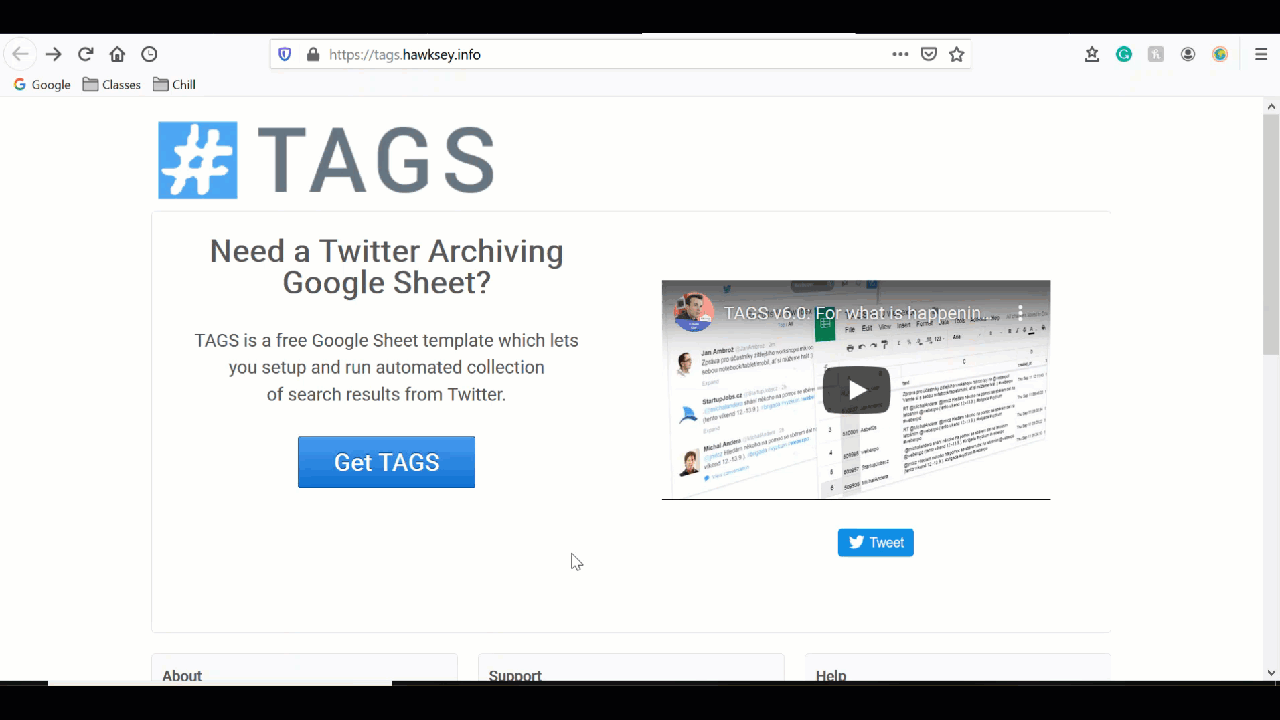
|
  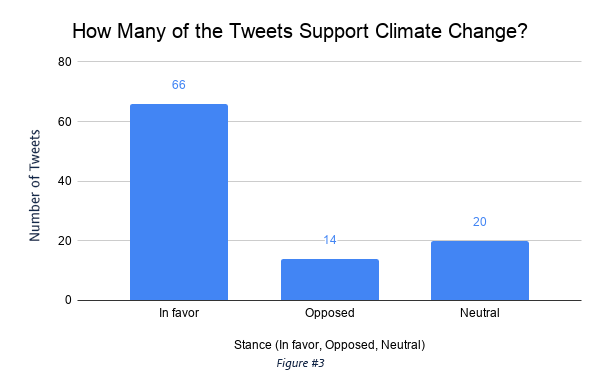 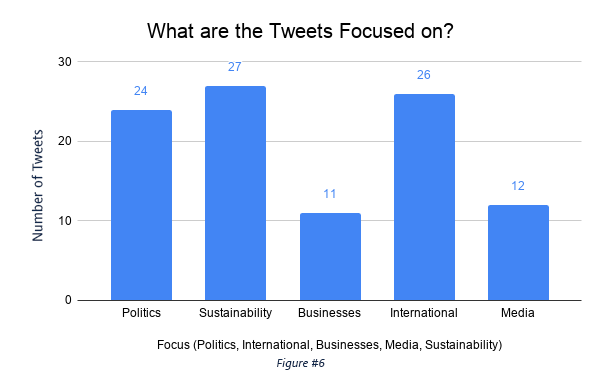
|
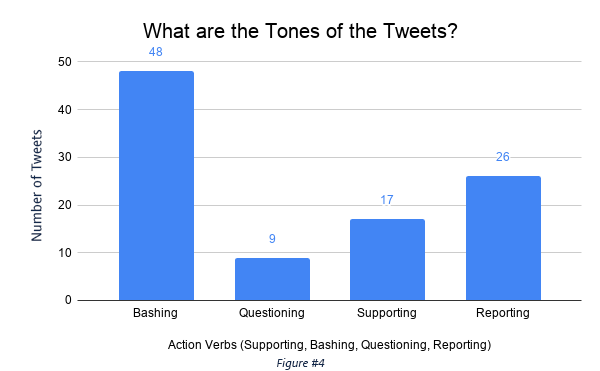
Once I settled on a hashtag that I wanted to use I did a little manipulating in the TAGS google spreadsheet to narrow down the amount of tweets I was going to have to analyze. Here is a comment I made that included the link to my google spreadsheet. I got the number of tweets I analyzed down to 100 by limiting my data to the past seven days, eliminating all retweets, and considering only the tweets that were written in English. I started to create columns to describe each of the 100 tweets like if the tweet was written by a guy or a girl, or if it was showing logos or pathos. I used this information to create graphs that I used to add visualizations to my twitter report. My analysis of the tweets included, males tweeted more on the subject, most of the tweets included a link to other information, the majority of the tweets believed climate change is a serious problem, a good amount of the tweets had bashing tones, and almost all of the tweets used pathos over logos. The focus of the tweets were all over the place and there is no clear majority but a lot of tweets focused on sustainability. 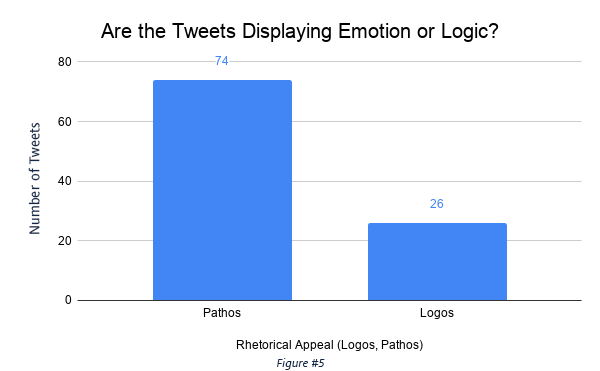 |
|
This is the draft of my twitter report. The content is very similar to my final draft though I did do a few revisions. When revising the Twitter Analysis Report I started by just fixing the grammatical errors that professor Anderson gave to me. This included when to have percentage signs and when not to, including figure numbers, and overall tightening my writing up. Next I worked on fixing some coding errors and creating better axis titles for my graphs. I found that I didn’t need to change too much on this project, the draft was basically at a finished level. I just went back and polished it. |
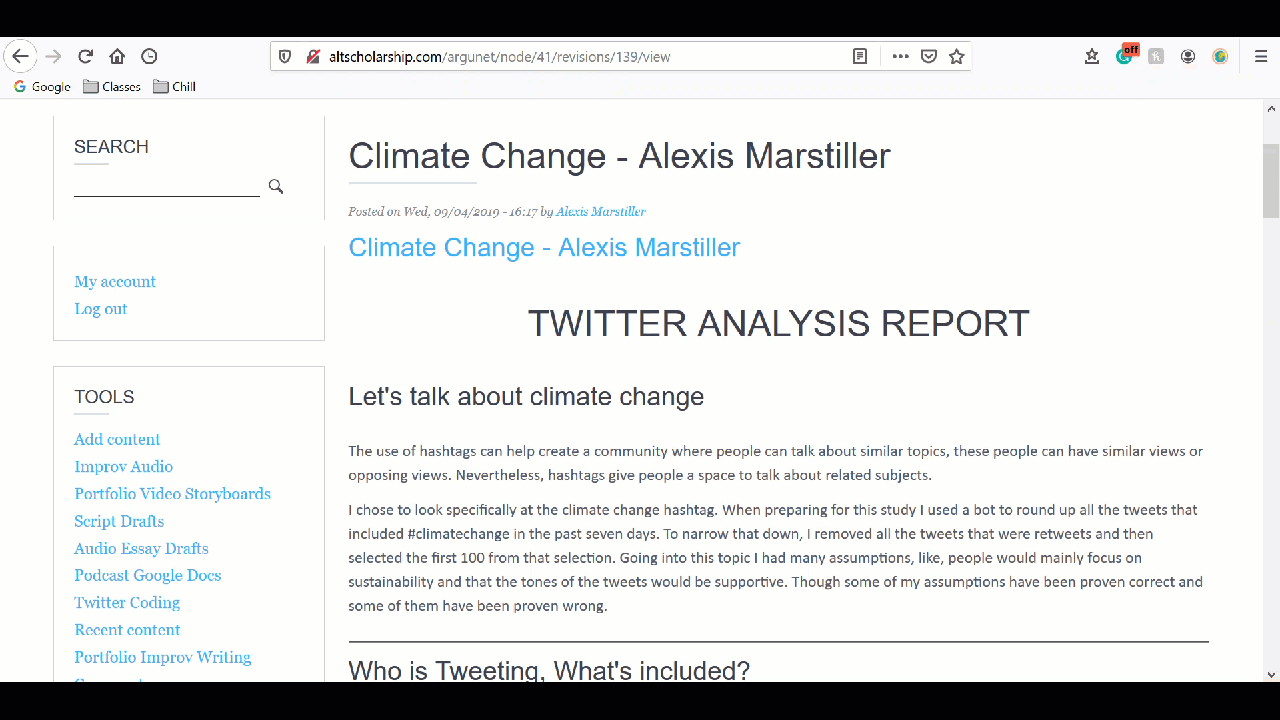
|
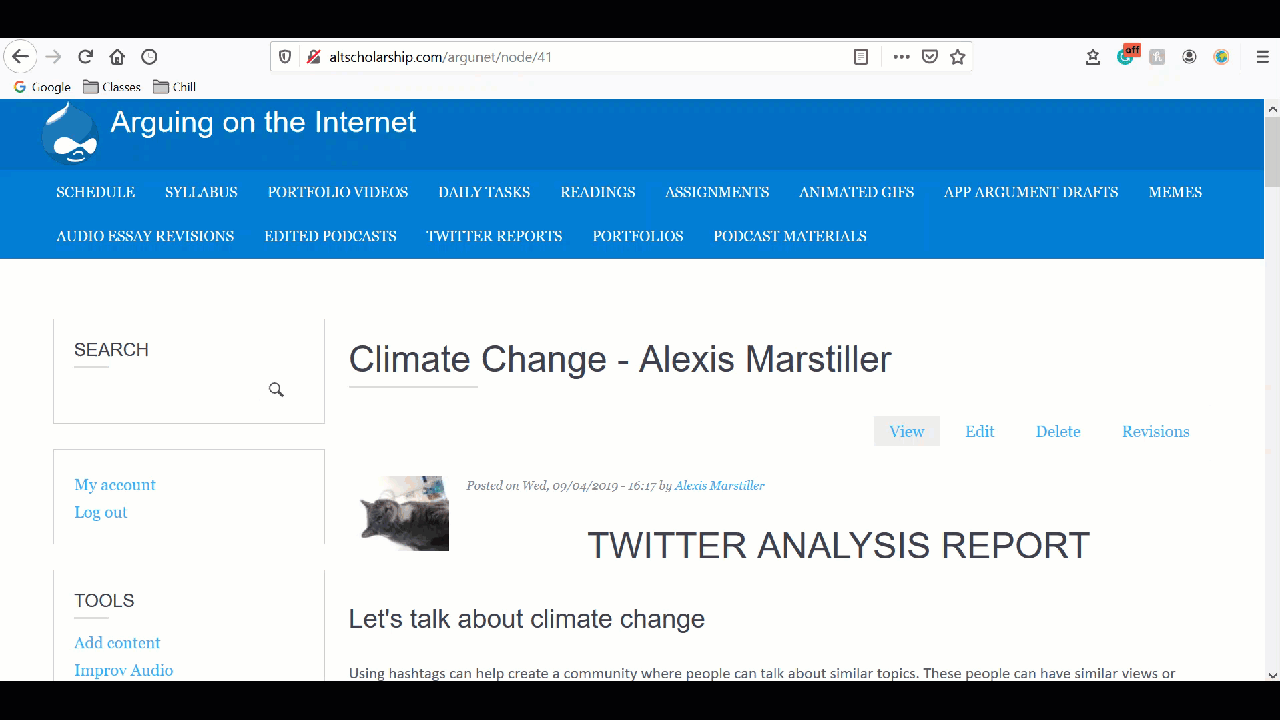
|
From this project I was able to work on problem solving. Particularly when it came to the coding part of this report. I had to work around embedding tweets that wouldn’t work if there was an emoji and some pictures hand weird squares under them. But figuring out a way around these issues built upon my problem solving skills. I worked hard to make the textual report less dull by breaking the text up with the graphs and inserting horizontal lines. When looking at logic versus emotion as aspects of internet argument I think about the twitter report project, it was the very first one we did in class. We look at about a hundred tweets and analyzed them, one of the things we focused on were if the tweets were showing signs of using logic or emotion. The other portion of this is ethos which is like credibility, which was very hard to come by when looking at tweets. Most tweets would include something that gave off signs of being more based on logic by using facts or numbers, or more based on emotion by giving personal experiences. Though this project really showed me that it wasn't all black and white, there were some cases were a tweet would show signs of using both logic and emotion which shows how complicated internet arguments can be. |
|
The next task was to create an audio essay. We were supposed to explore a topic associated with the themes of our class. I picked to focus on age limits on social media. We were told to conduct research on our topic and find scholarly videos or audio segments to use as evidence in our audio essay. We had to create a script that we would read off of when we started to record. Before we actually started recording we listened to examples of audio essays to get some inspiration. Here is a link to a comment I made on a few audio essays we listened to. While creating a draft of our script we read on article on how to script something that is going to be read out loud. Here is a link to a comment I made on how I was going to create a script. Here I have the first thing I created for my audio essay, the script. |

|
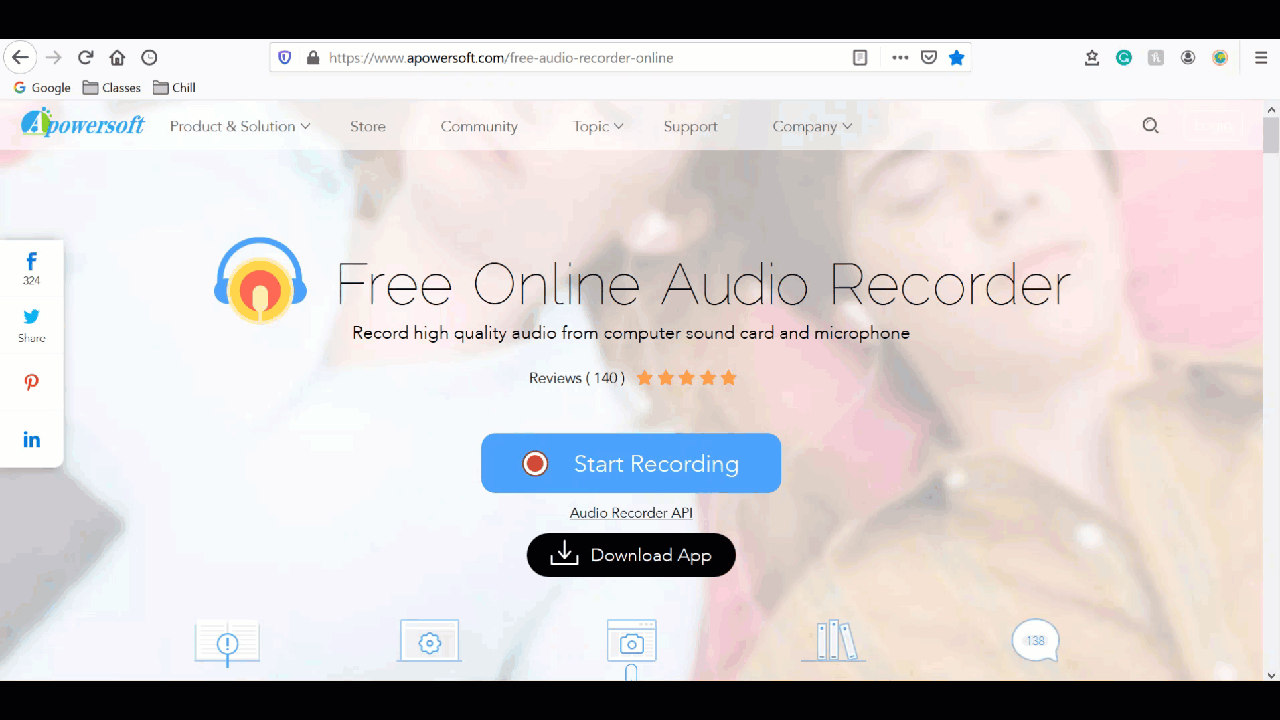
|
The next think we needed to complete for our audio essay was finding scholarly videos or audio recording of information regarding our topics. The topic I choice was if social media was considered and addictive substance and if so, she we have an age restriction on it. Here is a link to a comment I made on the scholarly videos I found for my audio essay. The next thing we did was practice using audacity, which is the program we used to create our audio essays. I’ve included the audio of the practice piece I had made in class. We were taught about the best way to collect sound files online, Professor Anderson gave us a few links to different sites for background music and different sound effects. He also taught us how to rip audio segments, which has come in handy not only in this class but in my other classes as well. |
|
Similar to the Twitter Analysis Report, my Audio Essay project draft was essentially at a finished level. The feedback I had received from my peer was majority positive only leaving a few comments on things that could be changed. My peer said things like, include more notification sounds with the typing at the beginning and make sure the background music doesn’t get too loud. A sample we looked at in class used a lot of dinging and notification sounds at the beginning, so I didn’t want to piggyback off that sample too much so I decided to just include the typing and a singular notification sound. I did take my peers' advice and faded out my background music a little more and raised my voice up slightly. My professor gave feedback as well, saying things like, delete the phrase “that states” and work on polishing transitions. After receiving my professor’s feedback I went back and deleted the phrase to tighten up the essay and I worked on not having such long gaps in between each clip to make those transitions smoother. |
|
|
|
We got feedback from not only our Professor but from our peers as well. I was able to get some valuable suggestions from my peers and I was able to give valuable criticism too my peers. Here is a link to the feedback I gave two of my peers. With all the suggestions I was given I was able to create my finished audio essay. In the essay I come to the conclusion that yes social media is addictive and should be taken as serious as other addictive substances. I also mention that there is already an age restriction on social media use, but because it isn’t enforced there is nothing stopping younger people from using social media. I ended it with telling the audience to use social media in moderation and leaving it to the parents to enforce the age restrictions of social media. Reflecting back on the entire audio essay there were a lot of moments when I wasn't sure what do to, specifically technical. I had a few problems with getting the music at the beginning just right and then working on having my voice levels correct. Because I had all these difficulties I was able to work on my problem solving abilities. If I wasn't able to figuring out how to do something, I use the resources available to me to figure out things out, those being YouTube tutorials, my professor, and classmates. |
|
Before going straight into the podcast project I've included a comment I made a few weeks ago on the difference between audio essays and podcasts. Audio essays are simply more like essays than podcasts. They are more scripted with audio clips that act like quotations that would be put into a written essay. You have to figure out how to weave in audio clips and have something to say about them just like you would with a written essay. Podcasts are more like a presentation in a class, where you know your topic and what you're going to say, but it's not memorized or written down anywhere word for word. It's more of a conversation, just like a class presentation is. In a podcast, you're explaining your material in a more relaxed manner. Audio essays also normally have a single person that's speaking and guiding the audience through the material, with only a few seconds of a different voice. Whereas podcasts may have someone that introduces the group, but it is normally made up of a lot of talking from multiple different people, there is no one person guiding us through all the main points. |

|
|
After being given the podcast assignment I thought it was going to be just like the audio essay assignment we had just completed. But then I found out it was going to be done in groups, and I let out a mental groan at the thought of a group project. As I’m sure my fellow students did. But it actually didn’t turn out that bad. Luckily my group worked well together so there wasn’t any problems with having to depend on each other to pull are own weight. This doesn't normally happen to me when I work in groups, so I actually had to learn how to sit back and trust my other partners to help with the project. The group had to come together and pick a topic to do the podcast on, we settled on how social media platforms are used politically. We had plenty of subtopics so everyone had something to talk about and we all helped each other along the way. |
|
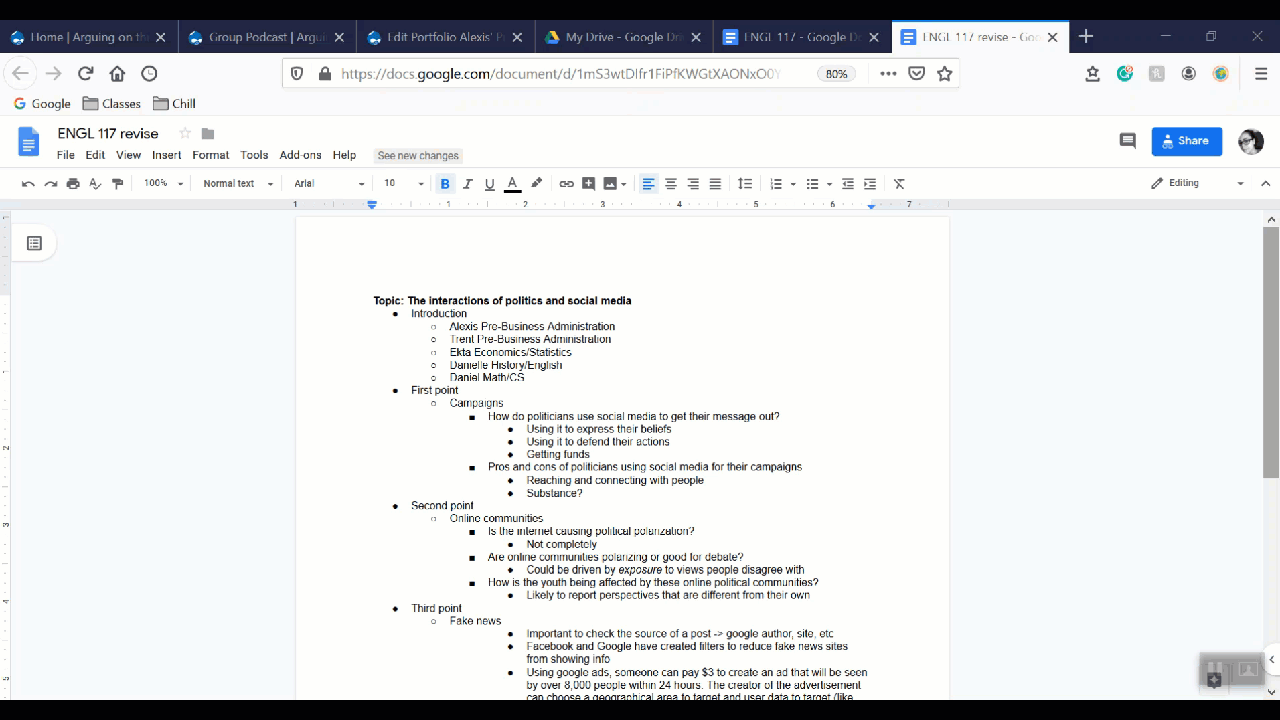
|
When working on creating our outline we focused on having it research driven. We all did a fair amount of research on our subtopics. We also didn’t use the outline the same way we used the script in the audio essay. For the audio essay we read directly off out script, for the podcast we had an outline of all the things we wanted to touch on. No member actually had the online up to even look at when we recorded the podcast except for the person that was leading the conversation. We did this because we really wanted the podcast to feel conversational and less like an essay, but we still wanted it to be focused. |
| The one project I think about the most when I think about collaboration is the podcast. This project was the only project that involved a lot of collaboration with the other student in the class. We were put into groups and from there had to figure out topics we all wanted to talk about. We shared the research and worked together to create talking points for the final podcast we did in class. Lucky my group worked very well together, and the collaboration went smoothly. This was the first time I had ever done a group podcast so I learn a few new things about collaboration that specifically tied to the development of a podcast. Like working to create a list of talking points instead of an entire script, and working on creating cues for when the next member should start talking. | 
|
|
Practice Take Official Recording Revised Podcast |
Revising the podcast was much different than with the twitter analysis report and the audio essay. Because each member of the group has a copy we each will go back and revise as we see fit. The first thing I did was cut out the beginning where there was random chatter before the podcast actually started. I also went in and amplified some of the softer voices in the group so they could be heard just as clearly as the rest of the group. There were also moments of silence in the group when we were waiting to see who would speak up on the subject, so I cut out those parts. I also faded out the music at the end a little better so it wasn’t as harsh. I've included our practice take on the podcast, the official podcast we performed in class, and my personally revised podcast for you to listen to. This project really let me develop my leadership and collaboration skills because there were times in the group when I was the only one that could do something, like I was the only one with a laptop that could record the podcast easily, I also took on the roll of the person who would play the intro and outro music. The podcast was purely a sonic medium for giving an argument, so our voice was the only thing conveying emotion and information. As simple as a change in tone could change the way the argument came across which shows the complexity of a podcast. |
|
When given the app argument project I was very excited. I had no idea what he was going to have us do, but once he explained the project to us, I saw a clear vision in my head as to what I wanted to do. Here is a link to a comment I made explaining my idea. In high school during lunch or during a relaxed class period, I’d try to use my laptop to just browse the web and I couldn’t do anything because of the web filters. It was so annoying, but eventually, after talking to people I found a way around the web filters, I could normally find just about any site I wanted to after typing in “unblocked” before whatever site I was trying to use. Even though I had this clear vision in my head, it was a little difficult to execute exactly how I wanted, especially being introduced to a completely to program. When I first started creating my site the colors were very boring and it overall looked very plain. Here is a link to a comment I made with a link to my first draft. When Professor Anderson told us about templates that we could find on the internet, I did a completely stylistic change on my app. |
|

|
While we were working on out apps we were assigned a reading that would explain to us a little about visual strategies. Being able to read about design elements was very helpful when it came to putting together my app, and it also really helped when we started to work on the memes. We were also asked to find an image online and discuss the visual strategies we found in the image. Being asked to critically think about an artistic image online helped me think critically about my own app design. Here is a link to a comment I made about a digital paint I had found. |
|
When revising the app argument, I took all the feedback I got from my professor and implemented in. He first said to maybe shorten the experience, so I went through and deleted some of the slides where the user is just mindlessly clicking through the slides. He also suggested making the blocked screen more unique to each of the websites. So for each different website, I give the blocked page a new description, and while doing this I noticed a lot of little typos that I went ahead and fixed. Along with fixing the typos I also tightened up my writing. Another thing my professor recommended I do is to add in the search bar to the last few slides to give it a little more depth, so I went back and did that.I learned a lot about how helpful receiving feedback can be. I've learned that being able to receive feedback and take criticism can actually help my projects in the long run. I've included my very first draft of the app for you to play through.
|
|
|
Creating the app was a mix between textual and visual mediums. I really wanted the app to be intuitive and explain the argument without many words. But I did include some text to help the player understand a little about the direction I was taking the argument. I had to be very careful with the amount of text that was used, and I had to work hard to make sure it wasn’t too wordy. I wanted the main aspect of this argument to be visual. Working in this new program made me hone in on my adaptability, I noticed that when switching between each program we used there was always so adaptability that had to be done. Working with this app really got me in the mindset for the next two projects. Memes and Gifs. |
|
I had never tried to create memes before, so when I was given the assignment to create three memes I had no clue what type of process I was going to have to take. I never really thought that the process behind making a meme would be difficult. When I see memes on social media most of them see really effortless and it’s almost as if memes just form naturally. But when I had to sit down and think about how I was going to create a meme it got more challenging than I’d like to admit. It wasn't necessarily technical problems that made this project challenging, it was being creative enough to come up with good ideas. |
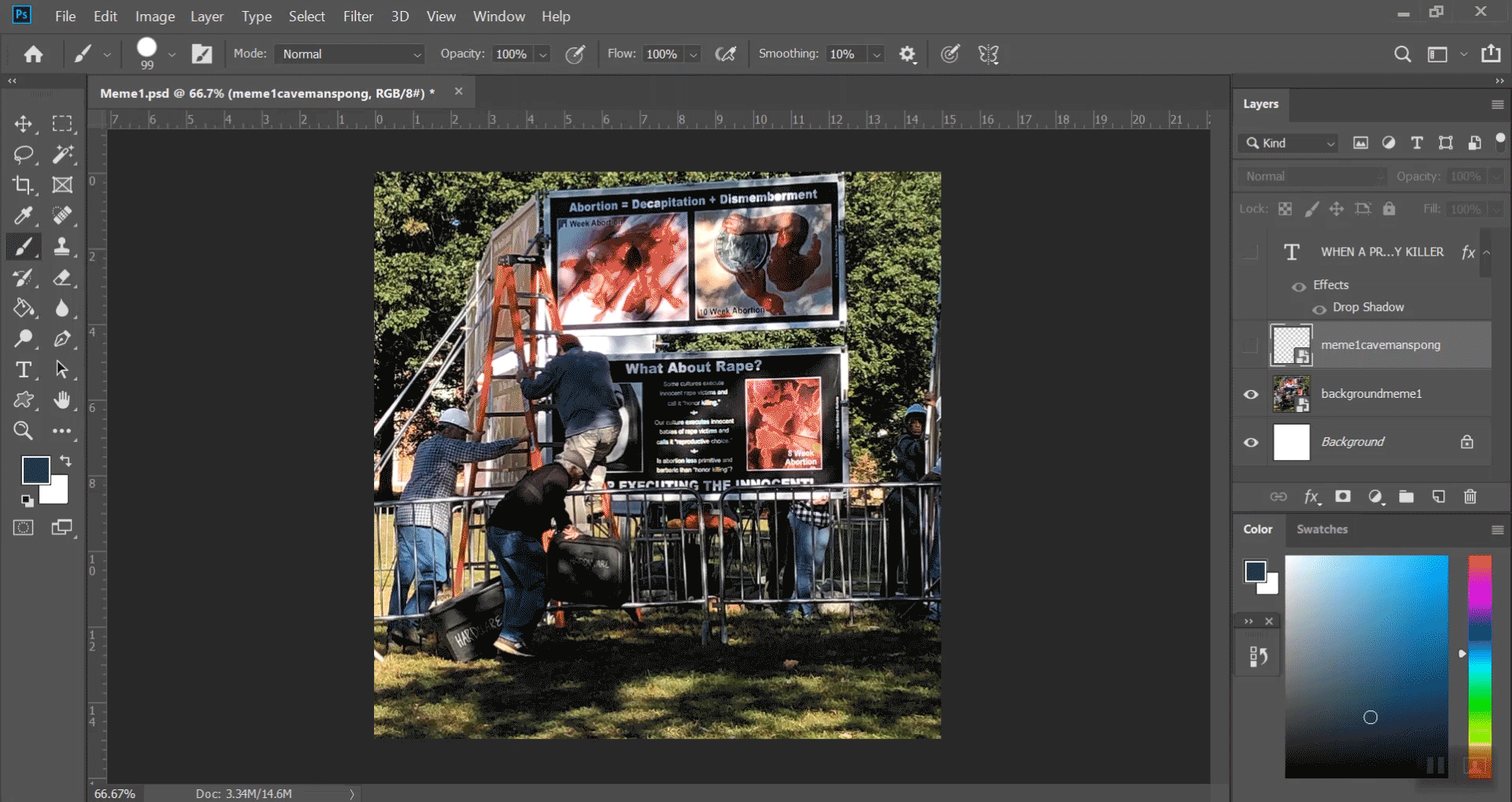
|

|
To help us with creating our memes Professor Anderson gave us a list of tutorial videos on how to use Photoshop. There was also an article he asked us to read that explain more about memes and which ones receive the most attraction. Here is a link to my comment on this article. We talked a lot in class about how to use visuals to give an argument. We thought about topics like the relationship between words and images, also about what happens when we mix images together. We also discussed controversial memes. Here is a link to my comments on the Pizzagate Meme. All these discussions we had in class set me up for success. Here is a link to a comment I made that has an example of some practice we did in Photoshop together. |
|
All of my memes had a common element of relating to Spongebob. I choice to create meets based off of Spongebob because I’m a fan of the show and I always find the Spongbob memes on social media really amusing. Because I used memes that were already in circulars it gave me a little help deciding on what words to use to create the meme because of the memes I’ve already seen. 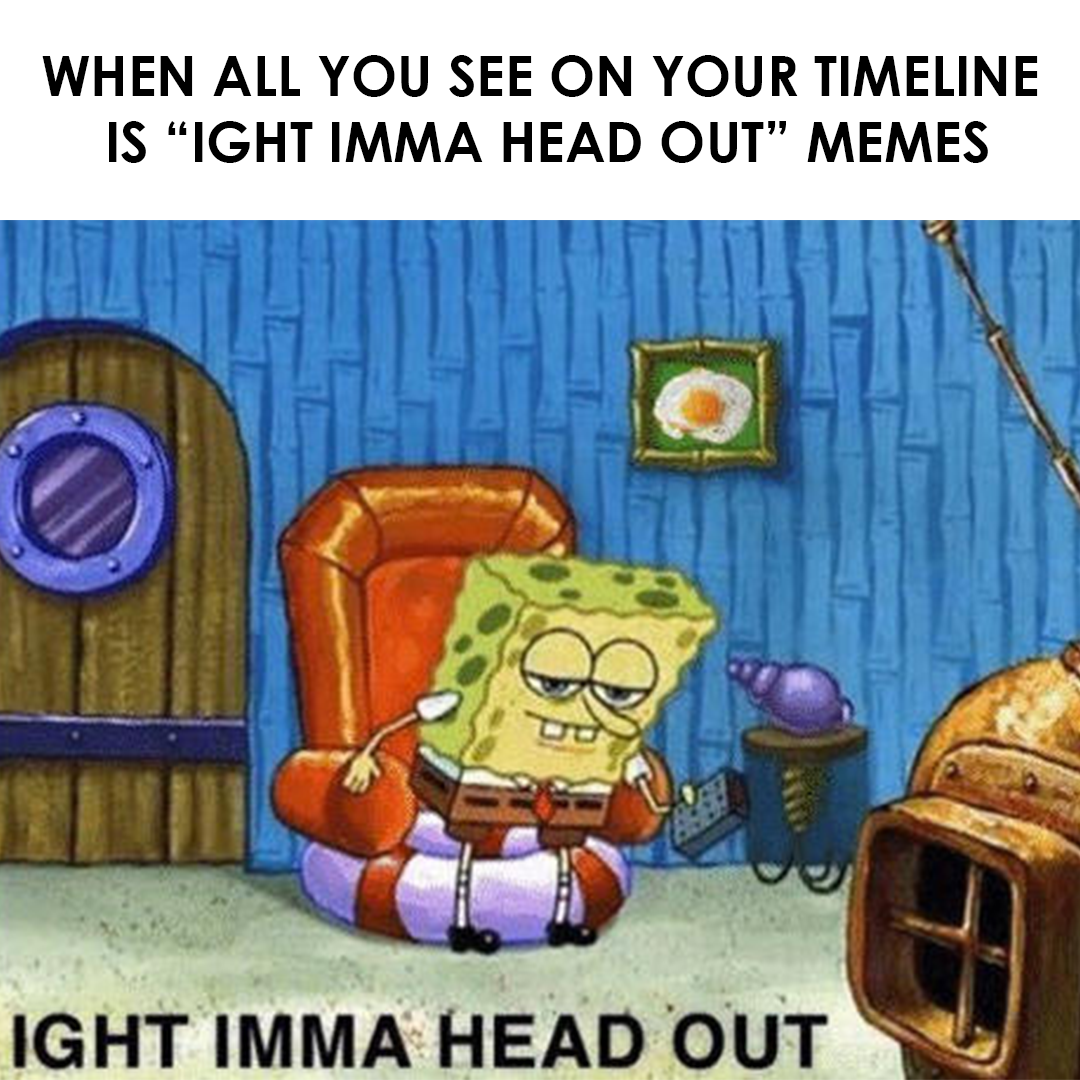
Creating the memes wasn’t very difficult for me because I have a lot of knowledge of Photoshop where we were making them. Because it wasn’t hard to create the memes I made five different one and then settled on three to submit. |
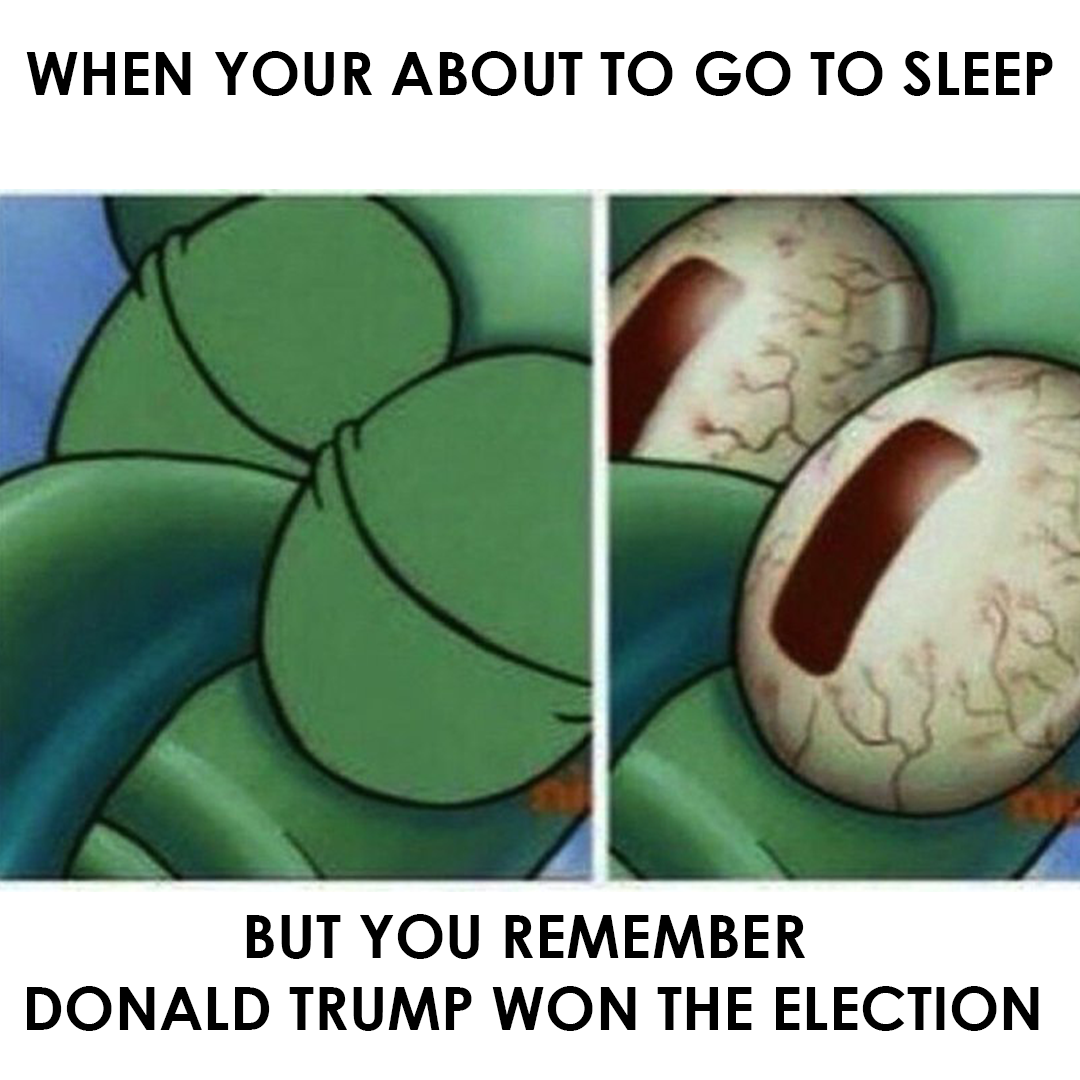
 |
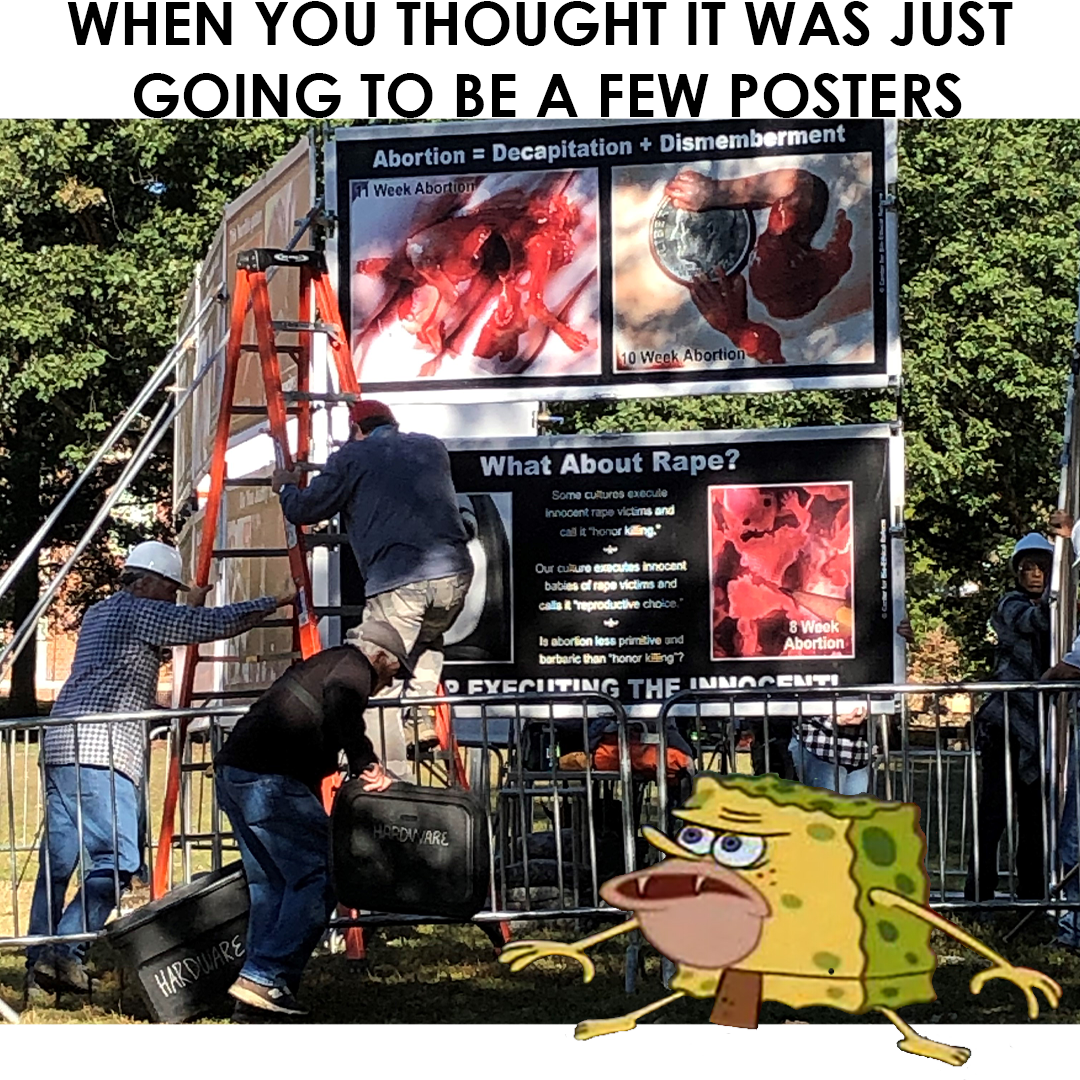
|
I decided to revise the very first meme I had made. It was the one that was the most controversial between my friends and I received a lot of mixed feedback on it. It’s the one about pro-life supported and the prehistoric Spongebob. I decided to add a white bored to make the text easier to read. I also changed the text up to be less harsh and hopefully more amusing. The memes were a mix of visual and textual based mediums and it required a lot of creativity and adaptability. Memes are a convenient way to spread an idea or argument, because if they are well done many people will repost them and the argument will be seen by many people. And while creating memes, sometimes something just goes wrong and you have to be able to roll with the situation to make the best of it. |
|
It took me awhile to look through all the meme images that were submitted by the class to find the one that best resonates with the concerns related to internet argument. But I finally settled on this image by Alex. It shows how the internet culture often takes subjects that are very serious and try to poke fun at them. It is unnerving that the world is actually seeing cases of measles again, but instead of people trying to come together and figure out a solution to these, we tend to see people just make jokes and laugh about the subjects, just hoping they’ll go away. |
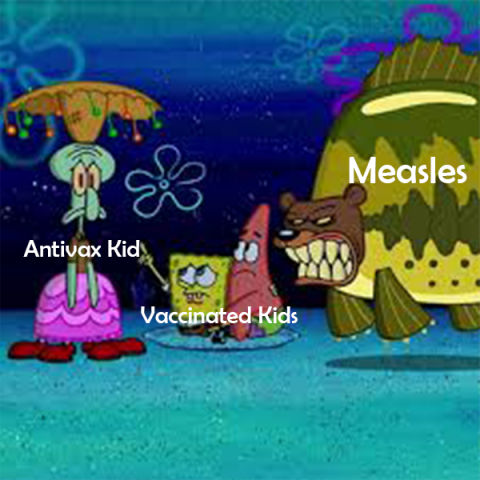
|
|
Our second to last project was the animated gifs. We’re almost at the end of the semester by this point. The gif project consisted of creating three different types of gifs. An animated gif argument, an animated gif art that resonates with an argument, and a screen-based experiment gif. Each of them were unique in their own ways, though they all had a mixture of visual and textual based media. Before we created our own gifs, we were asked to find three gifs, one for each category so we could get an idea of what our gifs should look like.Here is a link to the comment I made with the three gifs I had found. We also used some time in class to practice using Photoshop to create gifs. Here is a link to the comment that included my in class practice. |

|
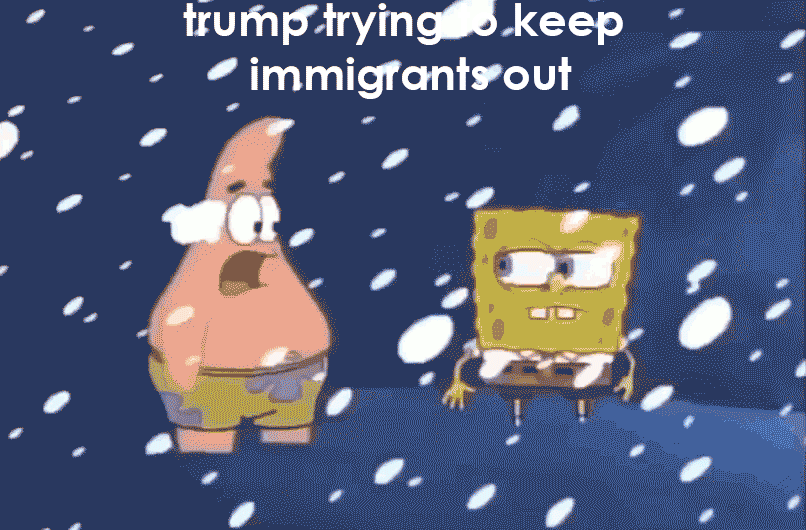
|

We were taught how to use snagit to rip videos from the internet. Which was very helpful for the gif project, the portfolio video project, and for creating this portfolio. When making my gifs I wanted to continue using the Spongbob theme, but I realized that trying to use only Spongebob related things got a little difficult. So I opened myself up for new ideas and came up with these three gifs.  |
|
When going back and trying to pick which gif I wanted to revise I was stuck between the art based gif and the screen based gif. I went with the screen based meme because I had a good idea for what I could do. I drew some inspiration from a few of my classmates and switched up the screen based gif from being based in Photoshop to being based on using folders some convey a meaning. I tried to get across the ups and downs of college, and I was poking fun at how people say college is more of a waste of money at this point in history. And I brought up how people have been saying that just a bachelor’s degree isn’t as impressive anymore, and people need to get a master’s degree to stand out. This project required a lot of creativity. Having to think of interesting idea and then figuring out a way to execute them took a lot of imagination, even though I had the technical skills. Gifs are a form of textual and visual mediums just like the memes. They are very similar when giving an argument, except you can guide the viewer of the gif towards your argument much more than you could with a meme because of the animations. |
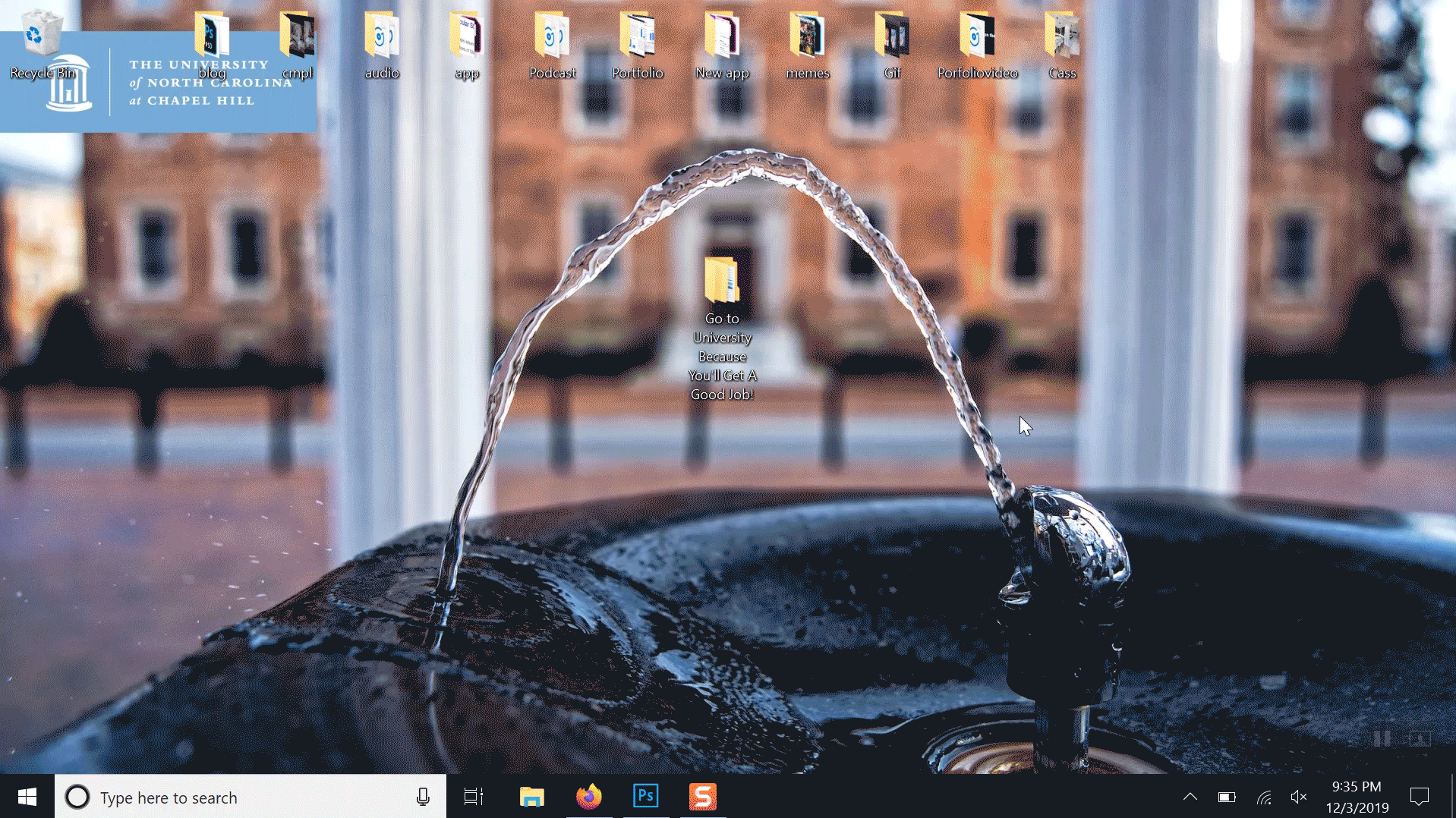
|

|
Just like with looking through the memes, it took me a while to look through all of the gifs the class and submitted to pick just one that I felt best resonates with the concerns we brought up in class that relate to internet argument. I ended up picking this gif by Amanda. It shows how again the internet culture takes real life subject that are very serious and just makes fun of them. All of us living in America can relate to first world problems, I know that I’ve looked in my fridge before and there had been plenty of food and I just not be in the mood to eat any of it and I’ll complain. It’s a real problem that people don’t think about until it’s brought into light. Often times these problems are brought into the light on social media platforms in a joking manner, like in this gif, and because they are shown in joking manners it takes away from their seriousness of the problem and leaves many people thinking nothing needs to be done. |
|
When given the portfolio video assignment I was excited to see what I could do and test my abilities. We were given the option to use the much similar program Adobe Premier Rush, though I wanted to try and use Adobe Premier Pro to see if I’d be able to pick up some new skill. In class we were shown some example videos as to what we should be going for. After seeing the example videos in class I got a lot of inspiration and ideas, but it soon became complicated because I didn’t know what direction I wanted to take the project. We worked on a storyboard first to get our ideas down, which I think helped me settle on what topics I wanted to think about. |
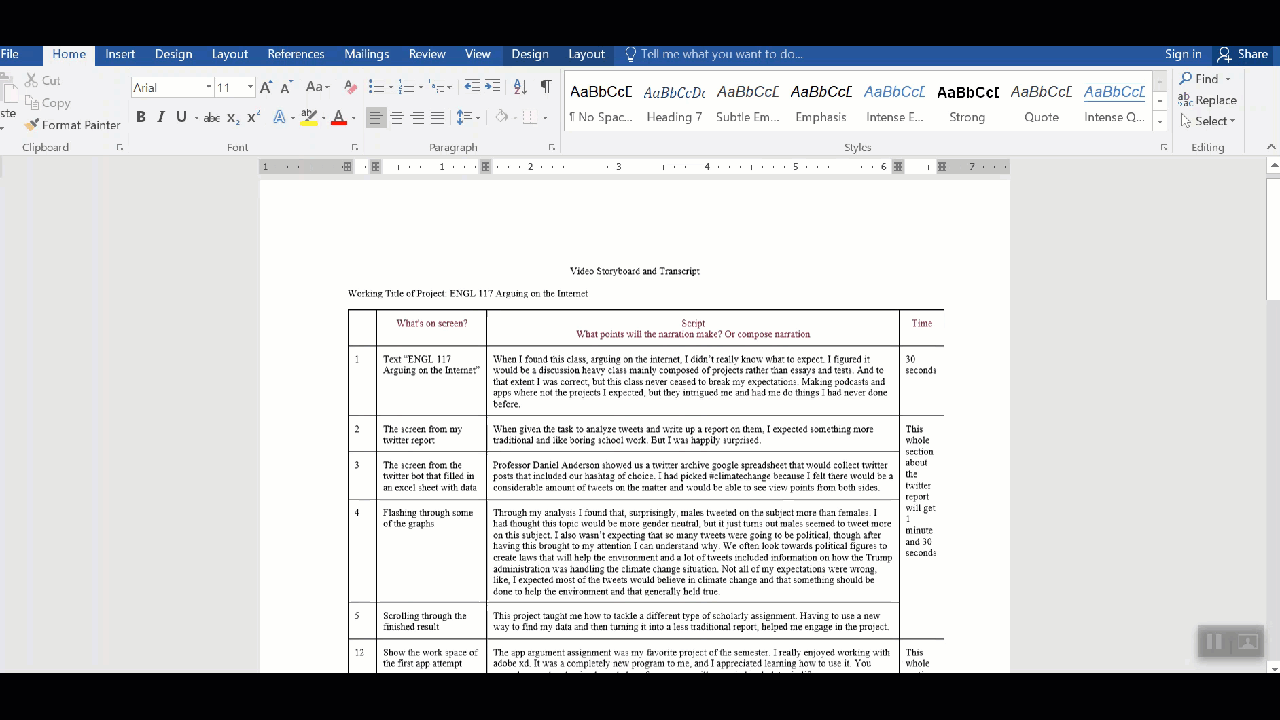
|

|
When editing the portfolio video I found it confusing to navigate through everything in Adobe Premier Pro. But after a while of using the program and looking up tutorial videos on YouTube to figure out how to do things I got the hang of it. The biggest thing was figuring out how to use the key frames and manipulating them. Once I figured that out, I was able to have a lot of fun in the program. I’m really glad I pushed myself to learn how to use this program because I’ve actually been assigned a final project in another class were I’m required to use Adobe Premier Pro. Now I already have some background in the program thanks to this class. |
|
Because I spent so much time figuring out how to use this new program and working on editing the video portion of the project, I didn’t spend much time working on the audio portion. I think the script could’ve been written a little better, and I also could’ve recorded the audio better. Instead of me going back and rerecording when I messed up, I tried to just crop out the parts where I said the wrong thing which lead to some of the audio parts sounding a bit choppy. In some parts of the audio it’s very obvious I just went back and cut something out because there are gaps in the audio and it just doesn’t flow well. But besides the audio being very rough, I enjoyed the visual part of the video though when I got back and revise I’ll probably tone down the dramatic transitions everywhere. |
|
|
I went back and looked at the storyboard I wrote for my portfolio video. I tightened up some of the wording and added a new more lines. After that I went and rerecorded all of my audio for the video portfolio. This time I tried to sound much more conversational, and if I noticed I stumbled on a word or a phrase I went back and side it again. This helped my audio come out much more clean. This time there was also less gasps in between my talking. After adding this new audio to the video portfolio I was much happier with the outcome. This project linked visual and sonic mediums together and I had to work really hard to get them to work together. I had to work on timing up the visuals to match the parts of the audio. I took a big risk trying to use Adobe premiere pro instead of Adobe rush, I could’ve really created a hole for myself, but I ended up learning a lot about the program and created a project I’m really proud of. |
|
When I found this class, arguing on the internet, I didn’t really know what to expect. I figured it would be a discussion heavy class mainly composed of projects rather than essays and tests. To that extent I was correct, but this class never ceased to break my expectations. Making podcasts and apps were not the projects I expected, but they intrigued me and had me do things I had never done before. Before classes start, a Sakai site is normally posted with the syllabus for the students to look over. This class didn’t have one up so the whole class was a surprise until the first day of class. On the first day when we all finally got the syllabus there was something exciting about the class. There have been few classes over the few semesters I’ve been in college that didn’t stress me out from day one, but this English class was one of them. The class discussions that we were able to have on a daily bases helped my communication skills, and I'm sure everyone else’s. I'm grateful that this class taught me so many real life skills that will continue to help me throughout my life. |


